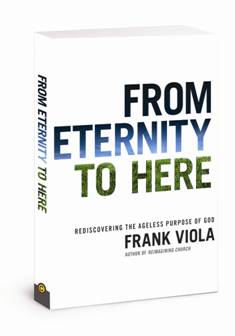Due to an oversight, the Christianity Today interview wasn’t included in the Complete List of Bloggers Q & A. Here it is in its entirety.
—
Unlike his previous volumes, Pagan Christianity and Reimagining Church, Frank Viola’s new book From Eternity to Here is not about church practices and forms. Instead, it tells the story of God’s eternal purposes in redemption from Genesis to Revelation. “I wrote the book,” Viola explains, “to bring back into view the greatness, the supremacy, the centrality, and the incomparable glory of the Lord Jesus Christ in the face of God’s immense purpose.” Leadership assistant editor Brandon O’Brien asked Viola a few questions about what his book means for local churches.
Do you think that someone could agree with you completely about what the church is and could be but disagree about the form a local church should take (i.e. traditional, denominational church vs. house or organic church)?
Absolutely. In fact, Christians from a wide variety of church forms and expressions have endorsed the book: Ed Stetzer  (Baptist), Alan Hirsh and Dan Kimball (Missional), Shane Claiborne (New Monastic), Myles Munroe and James Goll (Charismatic), Brian McLaren (Emergent), Greg Boyd (traditional evangelical church form), Leonard Sweet (Methodist, and who knows what else!), Michael Spencer (New Covenant-Reformation), Ralph Neighbor (Cell Church) are just some of them. In addition, I’ve received a fair share of enthusiastic mail from Anglicans on the one hand and Reformed folks on the other, both of whom have resonated strongly with the message of the book.
(Baptist), Alan Hirsh and Dan Kimball (Missional), Shane Claiborne (New Monastic), Myles Munroe and James Goll (Charismatic), Brian McLaren (Emergent), Greg Boyd (traditional evangelical church form), Leonard Sweet (Methodist, and who knows what else!), Michael Spencer (New Covenant-Reformation), Ralph Neighbor (Cell Church) are just some of them. In addition, I’ve received a fair share of enthusiastic mail from Anglicans on the one hand and Reformed folks on the other, both of whom have resonated strongly with the message of the book.
All told, From Eternity to Here is a book written for all of God’s people irrespective of which church forms and structures they might embrace.
What’s the relationship between the local, visible church and the invisible, universal church?
Traditionally, we have begun the Biblical story with the fall of humans in Genesis 3. The result is that the entire story places the salvation of humans and the redemption of the earth as being God’s goal. But those two elements, while part of the story, aren’t the beginning point nor the ultimate goal.
Thus when we begin the Biblical story in Genesis 1 and 2 (which occurs before the fall) and in Ephesians 1 and Colossians 1 (which occurs before creation), the Biblical story is reframed from the standpoint of God’s ultimate desire rather than with the needs of fallen human beings.
This changes the perspective dramatically, and it makes the story much larger and more God-centered. It moves us from a human-centered gospel to one that’s rooted in God’s relentless, eternal, and ultimate desire.
And herein lies the chief intention of God: to have a Bride for the Son, a House for the Father, a Body for the Son, and a Family for the Father.
In this light, the Bride, the Body, the House, and the Family have an identity and a reality in the eyes of God. You can call that reality and identity the ‘universal church,’ I suppose, but I think that term doesn’t do it justice. If we would stand on a new mountain and get behind the eyes of our Lord and see as He sees, it would change how we view God, the church, ourselves, and our brothers and sisters in Christ. (This is what the book attempts to do by tracing the purpose of the ages through Scripture.) However, the true identity and reality of the church can only be visibly expressed and practically fleshed out by local communities of believers.
What is one thing any church could do to take a step into “the ageless purpose of God?”
Moses saw the vision of the tabernacle on the heavenly mount before He could build it on the ground. This establishes a precious principle: Vision must precede building. By vision, I’m not speaking of a physical or mystical vision where a person goes into a trance and literally sees something. I’m speaking of a spiritual seeing, an insight, a “revelation” (as Paul uses the word in 1 Corinthians 14) into God’s eternal purpose. It’s knowledge that has the power to impact the heart, inspire the soul, and move our beings.
Hence, the first step, I think, is for God’s people to receive a vision of God’s ageless purpose — His grand and glorious mission (which includes, but goes far beyond the saving of souls and the healing of the planet). Such vision comes by the preaching of the eternal purpose or a written presentation of it along with the Holy Spirit’s illumination of it to our hearts. So to my mind, a church must first be acquainted with what the eternal purpose is before it can respond to it accordingly.



The Church is not peripheral to the world; the world is peripheral to the Church.
The heart beat of the universe is Jesus as He lives through his Body the Church, and his heart’s cry is RECONCILIATION…bringing everyone and everything together in Him.
The Church is the reconciling Body. “God was in Christ reconciling the world unto himself”.
(Based on Eugene Peterson’s introduction to Ephesians)